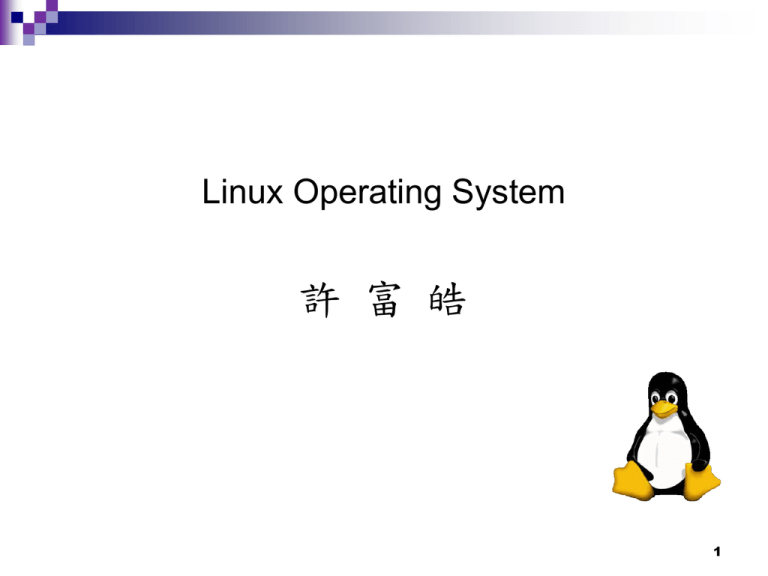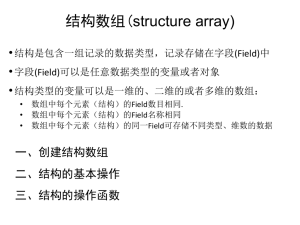
Linux Operating System
許 富 皓
1
Processes
2
Definition
A process is usually defined as
Hence, you might think of a process as the collection
of data structures that fully describes how far the
execution of the program has progressed.
an instance of a program in execution.
If 16 users are running vi at once, there are 16 separate
processes (although they can share the same executable
code).
From the kernel's point of view, the purpose of a
process is to act as an entity to which system
resources (CPU time, memory, etc.) are allocated.
3
Synonym of Processes
Processes are often called tasks or
threads in the Linux source code.
4
Lifecycle of a Process
Processes are like human beings:
they
are generated,
they have a more or less significant life,
they optionally generate one or more child processes,
eventually they die.
A small difference is that sex is not really
common among processes — each process has
just one parent.
5
Child Process’s Heritage from Its
Parent Process
When a process is created,
it
it
it
is almost identical to its parent
receives a (logical) copy of the parent's address space
executes the same code as the parent
beginning at the next instruction following the process creation
system call.
Although the parent and child may share the pages
containing the program code (text), they have
separate copies of the data (stack and heap), so
that changes by the child to a memory location are
invisible to the parent (and vice versa).
6
Lightweight Processes and
Multithreaded Application
Linux uses lightweight processes to offer
better support for multithreaded applications.
Basically, two lightweight processes may share
some resources, like the address space, the
open files, and so on.
Whenever
one of them modifies a shared resource,
the other immediately sees the change.
Of course, the two processes must synchronize
themselves when accessing the shared resource.
7
Using Lightweight Processes to
Implement Threads
A straightforward way to implement
multithreaded applications is to associate a
lightweight process with each thread.
In
this way, the threads can access the same set of
application data structures by simply
sharing the same memory address space
the same set of open files
and so on.
At
the same time, each thread can be scheduled
independently by the kernel so that one may sleep
while another remains runnable.
8
Examples of Lightweight Supporting
Thread Library
Examples of POSIX-compliant pthread
libraries that use Linux's lightweight
processes are
LinuxThreads,
Native
POSIX Thread Library (NPTL), and
IBM's Next Generation POSIX Threading
Package (NGPT).
9
Thread Groups
POSIX-compliant multithreaded applications are best
handled by kernels that support "thread groups."
In Linux a thread group is basically a set of lightweight
processes that
implement a multithreaded application
and
act as a whole with regards to some system calls such as
getpid( )
kill( )
and
_exit( ).
10
Why a Process Descriptor Is Introduced?
To manage processes, the kernel must have a
clear picture of what each process is doing.
It must know, for instance,
the
process's priority
whether
it is running on a CPU
or
blocked on an event
what address space has been assigned to it
which files it is allowed to address, and so on.
This is the role of the process descriptor a
task_struct type structure whose fields contain
all the information related to a single process.
11
Brief Description of a Process Descriptor
As the repository of so much information,
the process descriptor is rather complex.
In addition to a large number of fields
containing process attributes, the process
descriptor contains several pointers to
other data structures that, in turn, contain
pointers to other structures.
12
Brief Layout of a Process Descriptor
13
Process State
As its name implies, the state field of the
process descriptor describes what is
currently happening to the process.
It consists of an array of flags, each of
which describes a possible process state.
14
Types of Process States
TASK_RUNNING
TASK_INTERRUPTIBLE
TASK_UNINTERRUPTIBLE
__TASK_STOPPED
__TASK_TRACED
/* in tsk->exit_state */
EXIT_ZOMBIE
EXIT_DEAD
/* in tsk->state again */
TASK_DEAD
TASK_WAKEKILL
TASK_WAKING
TASK_PARKED
TASK_STATE_MAX
15
TASK_RUNNING
The process is
either
executing on a CPU
or
waiting to be executed.
16
TASK_INTERRUPTIBLE
The process is suspended (sleeping) until some
condition becomes true.
Examples of conditions that might wake up the
process (put its state back to TASK_RUNNING)
include
raising
a hardware interrupt
releasing a system resource the process is waiting for
or
delivering a signal.
17
TASK_UNINTERRUPTIBLE
Like TASK_INTERRUPTIBLE, except that delivering a
signal to the sleeping process leaves its state unchanged.
This process state is seldom used.
It is valuable, however, under certain specific conditions in
which a process must wait until a given event occurs
without being interrupted.
For instance,
this state may be used when
a process opens a device file
and
the corresponding device driver starts probing for a corresponding
hardware device.
The device driver must not be interrupted until the probing is complete, or
the hardware device could be left in an unpredictable state.
18
__TASK_STOPPED
Process execution has been stopped.
A process enters this state after receiving a
SIGSTOP signal
Stop Process Execution
SIGTSTP signal
SIGTSTP is sent to a process when
SIGTTIN signal
the suspend keystroke (normally ^Z) is pressed on its controlling tty
and
it's running in the foreground.
Background process requires input
SIGTTOU signal.
Background process requires output
19
Signal SIGSTOP [Linux Magazine]
When a process receives SIGSTOP, it stops
running.
It can't ever wake itself up (because it isn't
running!), so it just sits in the stopped state until
it receives a SIGCONT.
The kernel never sends a SIGSTOP
automatically; it isn't used for normal job control.
This signal cannot be caught or ignored; it
always stops the process as soon as it's
received.
20
Signal SIGCONT [Linux Magazine] [HP]
When a stopped process receives
SIGCONT, it starts running again.
This signal is ignored by default for
processes that are already running.
SIGCONT can be caught, allowing a
program to take special actions when it
has been restarted.
21
__TASK_TRACED
Process execution has been stopped by a
debugger.
When a process is being monitored by
another (such as when a debugger
executes a ptrace( ) system call to
monitor a test program), each signal may
put the process in the __TASK_TRACED
state.
22
Fatal Signals [Bovet et al.] (1)
A signal is fatal for a given process if
delivering the signal causes the kernel to
kill the process.
The SIGKILL signal is always fatal.
Each signal whose default action is
“Terminate” and which is not caught by a
process is also fatal for that process.
23
Fatal Signals [Bovet et al.] (2)
Notice, however, that a signal caught by a
process and whose corresponding signalhandler function terminates the process is
NOT fatal, because the process chose to
terminate itself rather than being killed by
the kernel.
24
TASK_WAKEKILL
[IBM]
TASK_WAKEKILL is designed to wake the
process on receipt of fatal signals.
#define TASK_KILLABLE (TASK_WAKEKILL | TASK_UNINTERRUPTIBLE)
#define TASK_STOPPED (TASK_WAKEKILL | __TASK_STOPPED)
#define TASK_TRACED
(TASK_WAKEKILL | __TASK_TRACED)
25
TASK_KILLABLE [IBM]
The Linux Kernel version 2.6.25 introduces a new
process sleeping state, TASK_KILLABLE:
If
a process is sleeping killably in this new state, it works
like TASK_UNINTERRUPTIBLE with the bonus that it
can respond to fatal signals.
26
TASK_WAKEKILL vs.
TASK_KILLABLE [IBM]
TASK_UNINTERRUPTIBLE
+
TASK_WAKEKILL
=
TASK_KILLABLE
27
New States Introduced in Linux
2.6.x
Two additional states of the process can
be stored both in the state field and in
the exit_state field of the process
descriptor.
As the field name suggests, a process
reaches one of these two states ONLY
when its execution is terminated.
28
EXIT_ZOMBIE
Process execution is terminated, but the
parent process has not yet issued a
wait4( ) or waitpid( ) system call to
return information about the dead process.
Before the wait( )-like call is issued,
the kernel cannot discard the data
contained in the dead process descriptor
because the parent might need it.
29
EXIT_DEAD
The final state: the process is being
removed by the system because the
parent process has just issued a wait4( )
or waitpid( ) system call for it.
30
Process State Transition[Kumar]
31
Set the state Field of a Process
The value of the state field is usually set with a
simple assignment.
For
instance: p->state = TASK_RUNNING;
The kernel also uses the _set_task_state and
_set_current_state macros: they set
the
state of a specified process
and
the state of the process currently executed,
respectively.
32
Execution Context and Process Descriptor
As a general rule, each execution context
that can be independently scheduled must
have its own process descriptor.
Therefore, even lightweight processes,
which share a large portion of their kernel
data structures, have their own
task_struct structures.
33
Identifying a Process
The strict one-to-one correspondence between
the process and process descriptor makes the
32-bit address of the task_struct structure a
useful means for the kernel to identify processes.
These addresses are referred to as process
descriptor pointers.
Most of the references to processes that the
kernel makes are through process descriptor
pointers.
34
Lifetime and Storage Location of
Process Descriptors
Processes are dynamic entities whose
lifetimes range from a few milliseconds to
months.
Thus, the kernel must be able to handle
many processes at the same time
Process descriptors are stored in dynamic
memory rather than in the memory area
permanently assigned to the kernel.
35
thread_info, Kernel Mode Stack,
and Process Descriptor
For each process, Linux packs two different
data structures in a single per-process memory
area:
a
small data structure linked to the process
descriptor, namely the thread_info structure
and
the Kernel Mode process stack.
36
Length of Kernel Mode Stack and
Structure thread_info
The length of the structure thread_info and
kernel mode stack memory area of a process is
8,192 bytes (two page frames) after Linux
2.6.37[1].
For reasons of efficiency the kernel stores the
8-KB memory area in two consecutive page
frames with the first page frame aligned to a
multiple of 213.
37
Kernel Mode Stack
A process in Kernel Mode accesses a stack contained
in the kernel data segment, which is different from the
stack used by the process in User Mode.
Because kernel control paths make little use of the
stack, only a few thousand bytes of kernel stack are
required. Therefore, 8 KB is ample space for the stack
and the thread_info structure.
38
Process Descriptor And Process
Kernel Mode Stack
The two data structures are stored in the 2-page (8 KB) memory area.
The thread_info structure resides at the beginning of the memory area, and the
stack grows downward from the end.
The figure also shows that the thread_info structure and the task_struct
structure are mutually linked by means of the fields task and stack, respectively.
39
esp Register
The esp register is the CPU stack pointer, which is
used to address the stack's top location.
On 80x86 systems, the stack starts at the end and grows
toward the beginning of the memory area.
Right after switching from User Mode to Kernel Mode,
the kernel stack of a process is always empty, and
therefore the esp register points to the byte immediately
following the stack.
The value of the esp is decreased as soon as data is
written into the stack.
Because the thread_info structure is 52 bytes long,
the kernel stack can expand up to 8,140 bytes.
40
Declaration of a Kernel Stack and
Structure thread_info
The C language allows the thread_info
structure and the kernel stack of a process
to be conveniently represented by means
of the following union construct:
union thread_union
{ struct thread_info thread_info;
unsigned long stack[2048];
/* 1024 for 4KB stacks */
};
41
Macro Current
before Linux 2.6.22
42
Identifying the current Process
The close association between the thread_info
structure and the Kernel Mode stack offers a key benefit
in terms of efficiency: the kernel can easily obtain the
address of the thread_info structure of the process
currently running on a CPU from the value of the esp
register.
In fact, if the thread_union structure is 8 KB (213 bytes)
long, the kernel masks out the 13 least significant bits of
esp to obtain the base address of the thread_info
structure.
On the other hand, if the thread_union structure is 4
KB long, the kernel masks out the 12 least significant
bits of esp.
43
Function
current_thread_info( )
This is done by the current_thread_info( )
function, which produces assembly language instructions
like the following:
movl $0xffffe000,%ecx
/*or 0xfffff000 for 4KB stacks*/
andl %esp,%ecx
movl %ecx,p
After executing these three instructions, p contains the
thread_info structure pointer of the process running
on the CPU that executes the instruction.
44
Get the task_struct
Address of Current Process
static __always_inline struct task_struct * get_current(void)
{
return current_thread_info()->task;
}
#define current get_current()
45
Macro Current
after and including Linux 2.6.22
46
current : the task_struct
Address of Current Process
Linux stores the task_struct address of current process in the per-CPU
variable current_task.
DEFINE_PER_CPU(struct task_struct *, current_task) ____cacheline_aligned =
&init_task;
#define this_cpu_read_stable(var) percpu_from_op("mov", var, "p" (&(var)))
static __always_inline struct task_struct *get_current(void)
{
return this_cpu_read_stable(current_task);
}
#define current get_current()
47
Macro percpu_from_op [1][2][3]
#define __percpu_arg(x)
__percpu_prefix "%P" #x
#define percpu_from_op(op, var, constraint)
\
({ typeof(var) pfo_ret__;
\
switch (sizeof(var)) {
\
case 1:
\
asm(op "b "__percpu_arg(1)",%0"
\
: "=q" (pfo_ret__)
\
: constraint);
\
break;
\
…
case 4:
asm(op "l "__percpu_arg(1)",%0"
: "=r" (pfo_ret__)
: constraint);
break;
case 8:
asm(op "q "__percpu_arg(1)",%0"
: "=r" (pfo_ret__)
: constraint);
break;
default: __bad_percpu_size();
}
pfo_ret__;
})
\
\
\
\
\
\
\
\
\
\
\
\
\
48
When will the Content of
current_task be Set[1]?
current_task is a per-CPU variable.
The value of current_task will be set at
the following two situations:
Variable Initialization
Context switch
49
Set the Value of current_task at
Variable Initialization
DEFINE_PER_CPU(struct task_struct *, current_task) = &init_task;
50
Set a New Value of
current_task at Context Switch
When making a context switch at __switch_to to
switch CPU to a different process (next_p),
__switch_to invokes this_cpu_write to store
the task_struct address of next_p in the perCPU current_task variable of related CPU.
this_cpu_write(current_task, next_p);
51
Linked List
52
Non-circular Doubly Linked Lists
A sequence of nodes chained together through two kinds of pointers:
a pointer to its previous node
and
a pointer to its subsequent node.
Each node has two links:
one points to the previous node, or points to a null value or empty list if
it is the first node
and
one points to the next, or points to a null value or empty list if it is the
final node.
53
Problems with Doubly Linked Lists
The Linux kernel contains hundred of
various data structures that are linked
together through their respective doubly
linked lists.
Drawbacks:
a waste of programmers' efforts to implement a
set of primitive operations, such as,
initializing the list
inserting and deleting an element
scanning the list.
a waste of memory to replicate the primitive
operations for each different list.
54
Data Structure struct list_head
Therefore, the Linux kernel defines the struct
list_head data structure, whose only fields
next and prev represent the forward and
back pointers of a generic doubly linked list
element, respectively.
It is important to note, however, that the pointers
in a list_head field store
addresses of other list_head fields
rather than
the addresses of the whole data structures in which
the list_head structure is included.
the
55
A Circular Doubly Linked List with
Three Elements
data
structure 1
data
structure 1
data
structure 1
list_head
list_head
list_head
list_head
next
next
next
next
prev
prev
prev
prev
56
Macro LIST_HEAD(name)
A new list is created by using the
LIST_HEAD(name) macro.
declares a new variable named list_name of type
list_head, which is a dummy first element that acts
as a placeholder for the head of the new list.
and
it initializes the prev and next fields of the
list_head data structure so as to point to the
list_name variable itself.
it
57
Code of Macro
LIST_HEAD(name)
struct list_head
{
struct list_head *next, *prev;
};
#define LIST_HEAD_INIT(name) { &(name), &(name) }
#define LIST_HEAD(name) \
struct list_head name = LIST_HEAD_INIT(name)
58
An Empty Doubly Linked List
LIST_HEAD(my_list)
next
prev
struct list_head my_list
59
Macro LIST_HEAD_INIT
#define LIST_HEAD_INIT(name) /
{ &(name), &(name) }
60
Relative Functions and Macros (1)
list_add(n,p)
list_add_tail(n,p)
list_del(p)
list_empty(p)
n
p
1
2
...
n
61
Relative Functions and Macros (2)
list_for_each(pos, head)
list_for_each_entry(p,h,m)
list_entry(ptr, type, member)
Returns the address of the data structure of
type type in which the list_head field that
has the name member and the address ptr is
included.
62
Example of list_entry(p,t,m)
sturct class{
char name[20];
char teacher[20];
struct student_pointer
struct list_head link;
};
name
*student;
struct class grad_1A;
struct list_head *poi;
poi=&(grad_1A.link);
list_entry(poi,struct class,link)
&grad_1A
(20 bytes)
teacher
(20 bytes)
student
(4 bytes)
link
next (4 bytes)
prev(4 bytes)
63
list_entry(ptr,type,member)
/**
* list_entry - get the struct for this entry
* @ptr:
the &struct list_head pointer.
* @type:
the type of the struct this is embedded in.
* @member:
the name of the list_struct within the struct.
*/
#define list_entry(ptr, type, member) \
container_of(ptr, type, member)
64
Code of container_of
typedef unsigned int
typedef __kernel_size_t
__kernel_size_t;
size_t;
#define offsetof(TYPE, MEMBER) ((size_t) &((TYPE *)0)->MEMBER)
#define container_of(ptr, type, member)
({ const typeof( ((type *)0)->member ) *__mptr = (ptr);
\
(type *)( (char *)__mptr - offsetof(type,member) );})
65
Explanation of list_entry(p,t,m)
offset
#define list_entry(ptr, type, member) \
((type *)((char *)(ptr)-(unsigned long)(&((type *)0)->member)))
list_entry(…)
name
(20 bytes)
poi - offset
teacher
offset
(20 bytes)
= list_entry()
student
(4 bytes)
poi
link
next (4 bytes)
prev(4 bytes)
list_entry(poi,struct class,link)
((struct class *)((char *)(poi)-(unsigned long)(&((struct
class *)0)->link)))
66
hlist_head
The Linux kernel 3.9 supports another kind
of doubly linked list, which mainly differs
from a list_head list because it is NOT
circular.
It can be used for hash tables.
The list head is stored in an hlist_head
data structure, which is simply
a
pointer to the first element in the list (NULL if
the list is empty).
67
hlist_node
Each element is represented by an
hlist_node data structure, which
includes
pointer next to the next element
and
a pointer pprev to the next field of the
previous element.
a
Because the list is not circular, the pprev
field of the first element and the next field
of the last element are set to NULL.
68
A Non-circular Doubly Linked List
struct hlist_head
struct hlist_node
struct hlist_node
*first
pprev
next
pprev
next
pprev
next
69
Functions and Macro for
hlist_head and hlist_node
The list can be handled by means of several
helper functions and macros similar to those
listed in previous sixth slide:
hlist_add_head()
hlist_del()
hlist_empty()
hlist_entry()
hlist_for_each_entry(),
and so on.
70
The Process List
The
process list is a circular
doubly linked list that links the
process descriptors of all existing
thread group leaders:
task_struct structure includes a
tasks field of type list_head whose prev
and next fields point, respectively, to the
previous and to the next task_struct
element’s tasks field.
Each
71
The Head of the Process List
The head of the process list is the
init_task task_struct descriptor; it
is the process descriptor of the so-called
process 0 or swapper.
The tasks->prev field of init_task
points to the tasks field of the process
descriptor inserted last in the list.
72
Code for init_task
#define INIT_TASK(tsk)
{
.state
.stack
.prio
.tasks
.real_parent
.parent
.children
.sibling
.group_leader
.thread
.fs
.files
.signal
.sighand
.nsproxy
\
= 0,
= &init_thread_info,
:
= MAX_PRIO-20,
:
= LIST_HEAD_INIT(tsk.tasks),
:
= &tsk,
= &tsk,
= LIST_HEAD_INIT(tsk.children),
= LIST_HEAD_INIT(tsk.sibling),
= &tsk,
:
= INIT_THREAD,
= &init_fs,
= &init_files,
= &init_signals,
= &init_sighand,
= &init_nsproxy,
:
.pids = {
[PIDTYPE_PID] = INIT_PID_LINK(PIDTYPE_PID),
[PIDTYPE_PGID] = INIT_PID_LINK(PIDTYPE_PGID),
[PIDTYPE_SID] = INIT_PID_LINK(PIDTYPE_SID),
},
.thread_group
= LIST_HEAD_INIT(tsk.thread_group),
:
}
\
\
\
\
\
\
\
\
\
\
\
\
\
\
\
\
\
\
\
\
\
73
Scans the Whole Process List with
Macro for_each_process
#define next_task(p) \
list_entry_rcu((p)->tasks.next, struct task_struct, tasks)
#define for_each_process(p) \
for (p = &init_task ; (p = next_task(p)) != &init_task ; )
The macro starts by moving PAST init_task
to the next task and continues until it reaches
init_task again (thanks to the circularity of
the list).
At each iteration, the variable p passed as the
argument of the macro contains the address of
the currently scanned process descriptor, as
returned by the list_entry macro.
74
Example
Macro for_each_process scans the whole
process list.
The macro is the loop control statement after
which the kernel programmer supplies the loop.
e.g.
counter=1; /* for init_task */
for_each_process(t)
{ if(t->state==TASK_RUNNING)
++counter;
}
75
The Lists of TASK_RUNNING
Processes – in Early Linux Version
When looking for a new process to run on a
CPU, the kernel has to consider only the
runnable processes (that is, the processes in
the TASK_RUNNING state).
Earlier Linux versions put all runnable processes
in the same list called runqueue.
Because it would be too costly to maintain the
list ordered according to process priorities, the
earlier schedulers were compelled to scan the
whole list in order to select the "best" runnable
process.
Linux 2.6 implements the runqueue differently.
76
Runqueue
in
Linux Versions 2.6 ~ 2.6.23
77
The Lists of TASK_RUNNING Processes – in
Linux Versions 2.6 ~ 2.6.23
Linux 2.6 achieves the scheduler speedup by
splitting the runqueue in many lists of runnable
processes, one list per process priority.
Each task_struct descriptor includes a
run_list field of type list_head.
If the process priority is equal to k (a value
ranging between 0 and 139), the run_list field
links the process descriptor into the list of
runnable processes having priority k.
78
runqueue in a Multiprocessor
System
Furthermore, on a multiprocessor
system, each CPU has its own runqueue,
that is, its own set of lists of processes.
79
Trade-off of runqueue
runqueue is a classic example of making
a data structures more complex to improve
performance:
to
make scheduler operations more efficient,
the runqueue list has been split into 140
different lists!
80
The Main Data Structures of a runqueue
The kernel must preserve a lot of data for
every runqueue in the system.
The main data structures of a runqueue are
the lists of process descriptors belonging to
the runqueue.
All these lists are implemented by a single
prio_array_t (= struct prio_array )
data structure.
81
struct prio_array
struct prio_array
{ unsigned int
unsigned long
struct list_head
};
nr_active;
bitmap[BITMAP_SIZE];
queue[MAX_PRIO];
nr_active:
the number of process
descriptors linked into the lists.
bitmap: a priority bitmap: each flag is set
if and only if the corresponding priority list
is not empty
queue: the 140 heads of the priority lists.
82
The prio and array Field of a
Process Descriptor
The prio field of the process descriptor
stores the dynamic priority of the
process.
The array field is a pointer to the
prio_array_t data structure of its
current runqueue.
P.S.:
Each CPU has its own runqueue.
83
Scheduler-related Fields of a Process
Descriptor
prio_array_t
unsigned int
nr_active
unsigned long
bitmap[5]
struct
[0]
list_head [1]
queue[140][x]
struct task_struct
struct task_struct
struct task_struct
:
:
:
int
prio
struct
list_head
run_list
prev
next
int
prio
struct
list_head
run_list
prev
next
prio_array_t
*array
prio_array_t
*array
:
:
int
.
.
.
prio
struct
list_head
run_list
prev
next
prio_array_t
*array
:
84
Function enqueue_task(p,array)
The enqueue_task(p,array)
function inserts a process descriptor
into a runqueue list; its code is
essentially equivalent to:
list_add_tail(&p->run_list, &array->queue[p->prio]);
__set_bit(p->prio, array->bitmap);
array->nr_active++;
p->array = array;
85
Function dequeue_task(p,array)
Similarly, the dequeue_task(p,array)
function removes a process descriptor
from a runqueue list.
86
Linux 3.9 Scheduler
87
Linux Scheduler
Linux is a multi-tasking kernel.
Multiple processes exist at a system at the
same time
The scheduler of a Linux kernel decided
which process is executed by a CPU.
88
Linux Scheduler Entry Point [Volker Seeker]
The main entry point into the Linux
process scheduler is the kernel function
schedule().
89
Overview of the Components of
the Scheduling Subsystem
90
Scheduling Classes (1)
Scheduling classes are used to decide
which task runs next.
The kernel supports different scheduling
policies
completely
fair scheduling
real-time scheduling
scheduling of the idle task when there is
nothing to do
91
Scheduling Classes (2)
Scheduling classes allow for implementing
different scheduling policies in a modular
way: Code from one class does not need
to interact with code from other classes.
When the scheduler is invoked, it queries
the scheduler classes which process is
supposed to run next.
92
Scheduling Classes (3)
Scheduling classes are represented by a special
data structure struct sched_class.
Each operation that can be requested by the
scheduler is represented by one pointer.
This allows for creation of the generic scheduler
without any knowledge about the internal
working of different scheduler classes.
93
struct sched_class
struct sched_class {
const struct sched_class *next;
void (*enqueue_task) (struct rq *rq, struct task_struct *p, int flags);
void (*dequeue_task) (struct rq *rq, struct task_struct *p, int flags);
void (*yield_task) (struct rq *rq);
bool (*yield_to_task) (struct rq *rq, struct task_struct *p, bool preempt);
void (*check_preempt_curr) (struct rq *rq, struct task_struct *p, int flags);
struct task_struct * (*pick_next_task) (struct rq *rq);
void (*put_prev_task) (struct rq *rq, struct task_struct *p);
:
void (*set_curr_task) (struct rq *rq);
void (*task_tick) (struct rq *rq, struct task_struct *p, int queued);
void (*task_fork) (struct task_struct *p);
void (*switched_from) (struct rq *this_rq, struct task_struct *task);
void (*switched_to) (struct rq *this_rq, struct task_struct *task);
void (*prio_changed) (struct rq *this_rq,struct task_struct *task, int oldprio);
unsigned int (*get_rr_interval) (struct rq *rq, struct task_struct *task);
:
};
94
Flat Hierarchy of Scheduling
Classes
An instance of struct sched_class
must be provided for each scheduling class.
Scheduling classes are related in a flat
hierarchy:
Real-time
processes are most important, so they
are handled before completely fair processes,
which are, in turn, given preference to the idle
tasks that are active on a CPU when there is
nothing better to do.
95
Connecting Different Linux
Scheduling Classes
The next element connects the
sched_class instances of the different
scheduling classes in the described order.
Note that this hierarchy is already set up at
compile time:
There
is no mechanism to add new scheduler
classes dynamically at run time.
96
Priority of Linux Scheduling
Classes (1) [Volker Seeker (1)]
All existing scheduling classes in the
kernel are in a list which is ordered by the
priority of the scheduling class.
The first member in sched_class called
next is a pointer to the next scheduling
class with a lower priority in that list.
97
Priority of Linux Scheduling
Classes (2) [Volker Seeker (1)]
The list is used to prioritise processes of different
types before others.
In the Linux versions described in this course, the
complete list looks like the following:
stop_sched_class → rt_sched_class →
fair_sched_class → idle_sched_class →
NULL
98
Priority of Linux Scheduling
Classes (3) [Volker Seeker (1)]
99
Stop and Idle Scheduling
Classes [Volker Seeker (2)]
Stop and Idle are special scheduling
classes.
Stop is used to schedule the per-cpu stop
task which pre-empts everything and can
be pre-empted by nothing.
Idle is used to schedule the per-cpu idle
task (also called swapper task) which is run
if no other task is runnable.
100
stop_sched_class [tian_yufeng]
The stop_sched_class is to stop cpu,
using on SMP system, for
load
balancing
and
cpu hotplug.
This class have the highest scheduling
priority.
101
schedule() vs. Scheduling
Classes [Volker Seeker (2)]
RT run
queue
CFS run
queue
102
Runqueue
in
Linux Versions 2.64 ~ 3.9
103
Run Queues in Linux Versions
2.6.24 ~ 3.9
Each CPU has its own run queue, and each
active process appears on just one run
queue.
It is not possible to run a process on
several CPUs at the same time.
104
struct rq
Run queues are implemented using the
struct rq data structure.
struct rq {
raw_spinlock_t lock;
:
struct cfs_rq cfs;
struct rt_rq rt;
:
struct task_struct *curr, *idle, *stop;
unsigned long next_balance;
struct mm_struct *prev_mm;
:
};
105
Fields of struct rq
cfs and rt are the embedded sub-run
queues for the completely fair scheduler and
real-time scheduler, respectively.
curr points to the task_struct of the
process currently running.
idle points to the task structure of the idle
process called when no other runnable
process is available.
106
runqueues array
All run queues of the system are held in the
runqueues array, which contains an
element for each CPU in the system.
On single-processor systems, there is, of
course, just one element because only one
run queue is required.
static DEFINE_PER_CPU_SHARED_ALIGNED(struct rq, runqueues);
107
Run Queue-related Macros
#define cpu_rq(cpu) (&per_cpu(runqueues, (cpu)))
static inline unsigned int task_cpu(const struct task_struct *p)
{ return task_thread_info(p)->cpu; }
#define task_rq(p) cpu_rq(task_cpu(p))
#define cpu_curr(cpu) (cpu_rq(cpu)->curr)
108
CFS Run Queue
109
Red-Black Tree [Wikipedia]
A node is either red or black.
The root is black.
All leaves (NIL) are black. (All leaves are same color as
the root.)
Every red node must have two black child nodes.
Every path from a given node to any of its descendant
leaves contains the same number of black nodes.
110
Properties of a Red-Black Tree
[Wikipedia]
The path from the root to the furthest leaf is no more
than twice as long as the path from the root to the
nearest leaf.
The result is that the tree is roughly height-balanced.
This theoretical upper bound on the height allows red–
black trees to be efficient in the worst case, unlike
ordinary binary search trees.
111
CFS Run Queue of a CPU
struct
struct
point to the scheduling
class the process is in
task_struct
rq
struct sched_class *sched_class;
struct
cfs_rq
cfs;
struct
:
rb_root tasks_timeline;
struct
rb_node *rb_leftmost;
:
struct
rt_rq
rt;
struct
:
:
rb_node run_node;
:
struct sched_entity se;
u64 vruntime;
:
vruntime used as key in
the RB-Tree
gravest need for CPU
112
struct
cfs_rq
struct cfs_rq {
struct load_weight load;
unsigned int nr_running, h_nr_running;
u64 exec_clock;
u64 min_vruntime;
#ifndef CONFIG_64BIT
u64 min_vruntime_copy;
#endif
struct rb_root tasks_timeline;
struct rb_node *rb_leftmost;
:
}
113
Fields of struct
cfs_rq
A CFS run queue is embedded into each per-CPU
run queue of the generic scheduler.
nr_running counts the number of runnable
processes on the queue.
tasks_timeline is the base element to manage
all processes in a time-ordered red-black tree.
rb_leftmost is always set to the leftmost element
of the tree, that is, the element that deserves to be
scheduled most.
114
struct sched_entity
struct sched_entity {
struct load_weight
struct rb_node
struct list_head
unsigned int
load;
run_node;
group_node;
on_rq;
/* for load-balancing */
u64
u64
u64
u64
exec_start;
sum_exec_runtime;
vruntime;
prev_sum_exec_runtime;
u64
nr_migrations;
:
:
}
115
Fields of struct sched_entity
run_node is a standard tree element that
allows the entity to be sorted on a redblack tree.
on_rq denotes whether the entity is
currently scheduled on a run queue or not.
The amount of time that has elapsed on
the virtual clock during process execution
is accounted in vruntime.
116
struct rb_node and struct
rb_root
struct rb_node {
unsigned long __rb_parent_color;
struct rb_node *rb_right;
struct rb_node *rb_left;
} __attribute__((aligned(sizeof(long))));
/* The alignment might seem pointless, but allegedly CRIS needs it */
struct rb_root {
struct rb_node *rb_node;
};
117
Supplement Materials
118
Situations Resulting in Calling the
Scheduler (1) [Volker Seeker]
Regular runtime update of currently
scheduled process:
function scheduler_tick() is called
regularly by a timer interrupt.
Its purpose is to update
The
runqueue clock
CPU load
and
runtime counters of the currently running process.
119
Situations Resulting in Calling the
Scheduler (2) [Volker Seeker]
Currently running process goes to sleep:
A
process which is going to sleep to wait for a
specific event to happen will invoke
schedule().
120
Situations Resulting in Calling the
Scheduler (3) [Volker Seeker]
Sleeping process wakes up:
The
code that causes the event the sleeping
process is waiting for typically calls
wake_up() on the corresponding wait queue
which eventually ends up in the scheduler
function try_to_wake_up().
121









